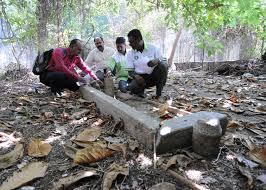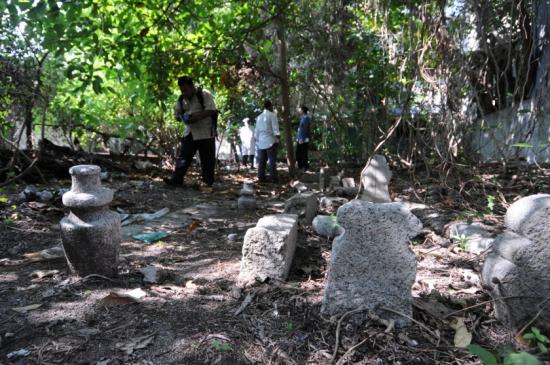Opalyn Mok
Source -http://www.themalaymailonline.com/features/article/in-crumbling-tombstones-penangs-link-to-ancient-chola

The now crumbling cemetery is the resting place of Chulier migrants that arrived Penang in the 1700s, April 14, 2014. — Pictures by K.E. Ooi -
Tucked behind a modern office block in George Town is a small plot of land with crumbling tombstones dating back to the late 1790s that may be Penang’s last link to the ancient Chola kingdom.
According to P. Asokan, the 14 tombstones mark the final resting place of some of Penang’s earliest migrants from India, known as Chuliers, who subsequently settled at the area that is now one of the heritage enclave’s most trafficked thoroughfare — Chulia Street.
“This area was where the Chuliers of the Chola Kingdom had settled and this is also the spot where early Indians and Indian Muslims such as the Malabari, Merican and Noordin clans had settled here about 200 years ago,” said the chairman of the Penang PAS Supporters’ Club.
Today, the narrow streets branching off Chulia Street have become Little India while another part, just off Chulia Street, was named Kampung Malabar where the Malabari clans lived.
However, there are little signs of the early settlers along Chulia Street today, better known as a backpackers’ heaven due to the myriad motels, bed and breakfast inns, bars and cafés jostling for space along the busy road.
The whole main street now exhibits a strong Straits Chinese influence, especially in the architecture of many of the pre-war buildings.
According to Asokan, this could be due to the later influx of Chinese settlers at the tail end of the 19th century, which saw the newcomers share the space with the Chuliers, Mericans, Malabaris and Noordins.
“In fact, the early Chinese settlers used to call this street “Lo Lin Ke”, which is a Hokkien reference to the Indian Muslim trader HM Noordin,” he said.
Asokan said the cemetery is an important piece of history but lamented its neglect over the years, despite Penang’s draw as a World Unesco Heritage Site.
Among the litter, discarded syringes lie half hidden in the undergrowth, and hint at the cemetery’s popularity as a drug addict’s haunt.
According to Asokan, a mosque frequented by Penang’s early Indian-Muslim settlers, once stood next to the cemetery.
Its only remaining structure is a wall, barely perceptible now after the building was turned into workshops for small- and medium-industries.
Asokan bemoaned the cemetery’s state of neglect, voicing fears that the rich history of the chuliers and the early Indian settlers in the area may soon be forgotten entirely.
He had taken reporters to the site today, hoping to highlight the need to preserve the cemetery and the remaining mosque wall.
He said he will be writing to the state government, the Penang Heritage Trust and also Universiti Sains Malaysia’s archaeological department for help.
“There should also be a Chuliers Heritage Trail in this area so that the history of this busy street is not forgotten just like that,” Asokan said.

The centuries-old cemetery of the early Indian Muslim settlers in Chulia Street is overgrown with bushes, weeds and trees. -